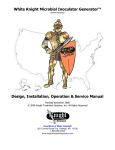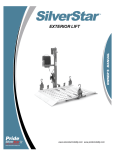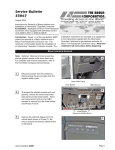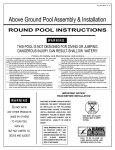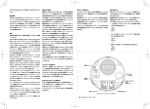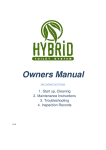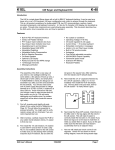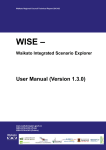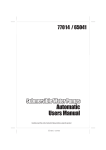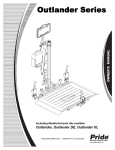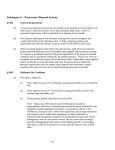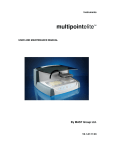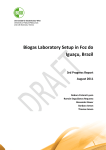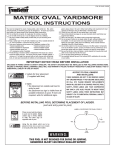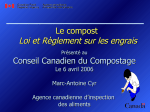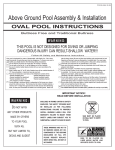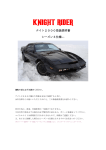Download White Knight Microbial Inoculator Generator™ Design, Installation
Transcript
White Knight Microbial Inoculator Generator™ (Patent Pending) Design, Installation & Service Manual For the State of Rhode Island January 2007 Guardians of Water Quality® 281 County Route 51a, Oswego, NY. 13126 1-800-560-2454 www.knighttreatmentsystems.com 1 TABLE OF CONTENTS I. Introduction to Enhanced Biological Augmentation, Pg. 3 II. Manufacturer’s General Specification, Pg. 4 III. White Knight Technical Information, Pg. 7 IV. Typical Residential Installation Diagram, Pg. 9 V. White Knight Site Qualification, Pg. 10 VI. White Knight Site Qualification Form, Pg. 12 VII. Installing the White Knight, Pg. 15 VIII. Operation & Service, Pg. 24 IX. Service Visit Form, Pg. 27 X. Rhode Island Department of Environmental Management’s Design Requirements, Pg. 29 2 “We don’t make the onsite treatment systems, we make them better” (I) INTRODUCTION The Enhanced Biological Augmentation of Onsite Wastewater Treatment Systems is the methodology of introducing a group of task specific selected microorganisms though inoculums in tandem with a microbial inoculation generation device that is placed into an onsite wastewater treatment train, typically the septic tank, to significantly improve overall treatment system performance, rehabilitate dysfunctional systems and assure system longevity. The White Knight Microbial Inoculator Generator™ was developed to continuously inoculate a septic tank or other treatment vessel with large numbers of naturally occurring selected strains of very powerful, non-pathogenic bacteria through the cultivation of IOS-500™ inoculums. Through airlift mixing, recirculation, and fine bubble aeration principles the device brings the selected bacteria into contact with fixed film substrate and the suspended organic compounds in a septic tank, or other process treatment vessel. The introduced pure cultures of bacteria grow at logarithmic rates as they voraciously digest most of the organic pollutants that are found in the wastewater and the organic waste compounds that have been transferred to the soil. The Fine bubble driven airlift features of the Microbial Inoculator Generator (MIG) are designed to allow for more efficient transfer of oxygen and low maintenance, high rate circulation of wastewater through the device, and across the fixed film media. An abundant oxygen supply supports a greater number of more robust bacteria providing more rapid digestion. Specifically designed clog resistant internal media provides for uninterrupted flow across abundant surface area for the establishment of the selected fixed-film culture. Many of the natural bacteria found in wastewater such as the coliform group are not as aggressive at decomposition and cannot compete with the selected IOS-500™ introduced cultures. The introduced cultures multiply in the tank and are carried by the effluent stream out to the soil enhancing its treatment capabilities and hydraulic functionality. 3 Deleted: fhat Deleted: (contaminated) soil. RIGHT WORD? (II) MANUFACTURER’S GENERAL SPECIFICATIONS: White Knight Microbial Inoculation Generation (MIG) Device: 1. The MIG device itself shall be manufactured from a rotationally molded single piece HDPE outer plastic housing. 2. The MIG device’s housing shall have an internally partitioned ballast area in the base of the unit that is easily fill able with ballast material in the field. 3. The internal ballast partition shall serve as the primary anchoring member for the fine bubble diffusion mechanism. 4. The internal fixed film media shall be of a clog resistant design that allows for the in service cleaning of the fine bubble diffusion membrane without disassembly of the MIG or requiring its removal from the tank. 5. The location of the inoculating matrix shall be in the vertical path of flow just above the fixed film media of the MIG and easily removable / insert able into the flow path while in operation. Inoculant: 1. Any bacterial inoculant employed shall hold well-documented records of historic performance in the field of biological remediation of heavily contaminated soils. 2. The biologically active components of the inoculant shall be listed with the American Type Culture collection. 3. The genome of the biologically active components of inoculants shall be known. Specific genes produce specific enzymes that regulate biochemical reactions, control rates of growth, the metabolism of substrates including consumption of complex hydrocarbons and nitrogen. 4. The inoculants shall be well documented as environmentally safe and non-hazardous to public health. 5. The introduced bacterial cultures shall possess a ravenous appetite for simple and complex organic carbon compounds and nitrogen and be capable of explosive population growth under favorable conditions. 6. The introduce bacterial cultures shall possess characteristics that are typical of organisms evolved to dominate seasonal environments and are tolerant of a wide range of temperatures. 4 Air Supply: 1. Air shall be supplied to the MIG by an external 115-volt AC single-phase linear air pump incorporating the manufacturer’s supplied Control Panel. 2. The Control Panel shall be UL listed, equipped with an audio / visual alarm system that senses the loss of air pressure and optional high water sensing contacts in a NEMA 4x enclosure with a pump run elapsed time meter. 3. Air supply pumps may be located in either an outdoor weather resistant enclosure or in an indoor protected area. 4. All relevant electrical work must comply with the appropriate electrical codes. 5. Air supply lines shall be installed in such a manner that provides protection from damage due to frost heave, vehicular and/or foot traffic. Deployment: 1. MIG installation shall only be provided by a manufacturer’s trained and certified provider in conformance with the manufacturer’s guidelines and under the appropriate regulatory requirements. 2. The MIG shall only be placed in structurally sound watertight vessels. 3. MIG Vessels shall provide for a minimum of 1.5 days residency time of the total estimated daily flow of wastewater from the property and in any situation no less than 1000 gallons in volume. 4. The outlet of the MIG vessel shall be equipped with an acceptable effluent filter. 5. All MIG vessels shall have acceptable service risers to facilitate monitoring and maintenance. 6. All MIG systems must employ a subsurface effluent dispersal system of appropriate size to handle the daily flow from the property being served when functioning properly. Service & Warranty: 1. A comprehensive service and manufacturer’s component warranty program shall be provided to the property owner for each MIG installed. 2. Service of the MIG shall only be conducted by manufacturer trained and authorized providers in compliance with regulatory requirements and at a minimum of 6-month intervals. 5 Accepted MIG & Manufacturer: 1. “ White Knight Microbial Inoculator Generator™” Knight Treatment Systems, Inc. 281 County Route 51A Oswego, NY 13126 1-800-560-2454 Accepted Inoculums: 1. “IOS-500™” International Wastewater Solutions, Inc. PO Box 157 Sebastopol, CA 95473 707-887-1811 6 (III) White Knight Technical Specifications & Drawings Model Numbers and Typical Applications WK-40 Residential applications WK-78 Large residences and small commercial applications WK-1xx Larger, custom designed, or municipal applications Treatment Unit Specifications Model # Maximum recomme nded BOD loading (lbs/day) Minimum Tank Size (gallons) # of Media Towers Size of Media Tower (dia” x height”) Minimum Air Pipe size Recommend ed maximum number of bedrooms Approx Diffuser Air Flow (CFM) WK-40 4 1000 1 16” x 27.5” ½” 5 1 WK-78 6 1000 2 16” x 27.5” ¾” 8 2 Varies 1000 Varies 16” x 44” ¾” varies Varies WK1xx Air Supply Specifications Model # Pump Model # Output @ 2 psi (CFM) Watts Amps Volts Pump Dimensions Basin Dimensions WK40 Thomas 5040A 1.58 38 0.9 115 6.83” x 8.09” x 7.79” 13” H x 24” L x 16” W WK78 Thomas 5078S 3.2 92 2.1 115 8.94” x 7.05” x 8.59” 13” H x 24” L x 16” W WK1xx Call for specifications 7 Controller Specifications Model # Voltage Amps Max Failure sensing Alarm Type Overload protection (amps) Switching WK-40 115 8 Pressure drop +/or float Visual and Audible 8 Normal/ Silence only WK-78 115 8 Pressure drop +/or float Visual and Audible 8 Normal/ Silence only WK-1xx 115 Varies Pressure drop +/or float Visual and Audible varies Normal/ Silence only White Knight MIG Tower Drawing 1" PVC PIPING FIELD ADJUSTED TO HEIGHT 12.00 INSIDE ZIP TIES 1/4" THICK WALL IOS 500 INOCULANT PACKET 27.5" 54x 1" ID TUBULAR MEDIA SECTION 1 US FILTER FLEX DISC FINE BUBBLE DIFFUSER 9IN. DIAMETER SECTION 1 SECTION 2 1.5" DIA. BALAST COMPARTMENT PLUG PILATED WRAP 10 X 1.50" EQUALLY SPACED 1/2" PVC VERTICAL CROSSECTION SECTION 2 KNIGHT TREATMENT SYSTEMS, INC. 281 COUNTY ROUTE 51A, OSWEGO, NY 13126 WWW.KNIGHTTREATMENTSYSTEMS.COM PROJECT ID: PAGE 1 OF 1 REVISION DATE: SCALE: DRAWING #: DRAWN BY: DJN 8 (IV) Typical Residential Installation Diagram Typical Residential Installation 1 2 7 4 4 3 8 5 1. 2. 3. 4. 5. 6. 7. 8. 6 115 volt electrical supply through Alarm Panel to Air Pump Air pump installed in weather tight basin, outdoor location ½” ID plastic air supply line Service riser for monitoring and maintenance White Knight Microbial Inoculator Generator™ Effluent Filter System Alarm Panel IOS-500™ Inoculant Packet 9 (V) White Knight Site Qualification The White Knight Microbial Inoculator Generator’s success is directly linked to the proper determination of the root cause of an onsite system’s dysfunction. In order to determine whether or not the dysfunctional system’s is a candidate for enhanced biological rehabilitation a through site evaluation must be performed. To this end a competent, authorized entity shall perform a comprehensive site evaluation and owner/operator interview to determine the actual nature of the problem(s) being experienced. The system’s infrastructure must be sound and free of defect. Septic Tanks, Distribution Boxes and other components must be evaluated and repaired or replaced if found to be damaged or deficient. Absorption Systems constructed of antiquated materials such as “Orangeburg Pipe” and/or “Wooden Plank Trenches” should be replaced. Surface water runoff infiltrating the system will have a major impact on the hydraulic performance and treatment efficiency of the absorption system contributing to its dysfunction. Sources of concentrated flow from impermeable areas such as rooftops and driveways must be identified and directed away from system components. Visiting a dysfunctional system during or shortly after a significant rain event can be invaluable tool in assessing the drainage patterns of the property. 10 Inflows from leaky plumbing fixtures place a tremendous burden on the absorption system. Water continuously trickling into the septic tank is a positive sign that either inflow and/or infiltration are taking place. Illicit discharge from sump pumps into the system may also be a contributing factor. Condensate from heating / air conditioning appliances and water softener backwash have been demonstrated to impact the processes of wastewater treatment systems. Conduct an in the home survey of all water using fixtures and any sump pump connections in the presence of the property owner and identify the appropriate corrective measures that would need to be taken. The physical verification of the existence of a clogging mat is an important evaluation practice. Typically the upslope edge of the absorption system is located with a probe and a small excavation is created in close proximity above the system to a depth below the bottom of the absorption system. Depth to ground water and its movement plays a major role in the functionality of an absorption system and its ability to treat wastewater within. The hydrology of a lot can be impacted and dramatically change from the time of original system siting due to neighboring development. In such a situation the installation of a swale, curtain or perimeter drain may become a necessity to keep the absorption from becoming saturated. Once the excavation is made and ground water is not encountered the excavation is moved towards the absorption system’s soil interface to establish the presence of the clogging mat. Typically the internal hydrostatic pressures of the absorption system will breach the clog mat and fill the hole with effluent. The thickness of a clog mat will vary and is dependant upon soil structure and texture. Loose granular soils exhibit a thicker and more pronounced appearance over tighter soils. 11 (VI) White Knight Site Qualification Form Date _______________________ Name _______________________________ Home ( Address _______________________________ Office ( ) ______-__________ Town/City _______________________________ Mobile ( ) ______-__________ State E-mail ______________________ ___________ Zip __________ ) ______-__________ Mailing address if different from above: _________________________________________ __________________________________________________________________________ Description/Directions ______________________________________________________ __________________________________________________________________________ __________________________________________________________________________ Regulatory Authority Agency _______________________________ Address Office ( _______________________________ Town/City _______________________________ State ________________ Zip __________ Permit Number ______________________ _____ FAX ) ______-__________ ( Mobile ( ) ______-__________ ) ______-__________ E-mail ______________________ Date of Issuance ______________ Contact Person ___________________________ Plans / Permit Available? Y N Trouble Symptoms Drain back-up ___ Visible effluent ____ Lush vegetation ____ High tank level ____ Odor ____ Frequent Pumping ___ Other ____________________________________ 12 Qualifying Interview Septic System Age of system ___________ Plan available Y N Septic tank size __________ Tank Material Pump chamber Y N Distribution box Date last pumped ___________ Concrete Plastic Metal Y N Unk Leachfield type & size PVC/stone___ Plastic Chambers___ Concrete Chambers___ Seepage Pit___ Other (specify) __________________________________________________________________ Prior attempts to fix system Y N If yes, what and when _______________________________ _________________________________________________________________________________ _________________________________________________________________________________ _________________________________________________________________________________ Building How long have you lived in this home? ____ years Single Family ____ # Bedrooms ____ # Bathrooms ____ Garbage Disposal Unit? Y Water Supply? Well N Hot tub, spa, whirlpool bath? Y N Municipal If well, does a water purification/softener backwash discharge into septic system? Y N Does the property have a sump pump? Y N Y N Laundry discharge into septic system? N Y Discharge into septic system? Laundry detergent? Liquid Powder Describe Laundry & Cleaning Habits: ___________________________________________________ Have any bedrooms been added since installation of original septic system Y #___ Has usage of property changed since installation of original septic system? Y N N If yes, describe changes. ______________________________________________________ 13 Site Visit Time and Date of Site Visit _________________________________________________________ Septic tank size __________ Tank Material ___________ Tank Condition ____________________ Center Access Y N Discharge Access Y N Date of Pump Out & Name of Pumper _________________________________________________ Tank Height to Discharge Invert ________ Baffle condition ____________ Depth of tank below grade _________ Discharge effluent level ______" above invert Discharge line description ____________________________________________________________ Effluent level in leach field/trenches _____________________________________________________ Biological clogging confirmed Y N Soil Type & Description _______________________________________________________________ Depth to Ground Water ____________ Storm Water / Snow Melt Infiltration? Y N Apparent structural damage or other unusual findings_______________________________________ __________________________________________________________________________________ Installation Requirements Length of air line run ________ft Jet Lines Y Length of electrical run ______ft Tank pumping Y Tank top modification Y N N Baffle removal Y N N Tank is: Concrete___ Plastic____ Steel____ Depth of tank top from finished grade ______in. Need _________in. of riser Discharge line or other modifications needed: ________________________________________________________________________________ ______________________________________________________________________ Does System qualify for White Knight? Y N Evaluation Performed By: _____________________________________ 14 (VII) Installing the White Knight Important Note: The following directions are provided with the assumption that those involved with the installation of the White Knight Microbial Inoculator Generator hold knowledge of, adhere to, practice and promote the protection of the health and safety of their colleagues, the public and the environment. Becoming educated in and complying with all Industry and OSHA Safety Requirements and governing Regulatory Requirements is the sole responsibility of the installer. Knight Treatment Systems, Inc. assumes no risk or liability for any omissions or actions of the installer or by others associated with the installation. 1) Expose the top of septic tank. An approved riser system must be used where absent at the location where the White Knight™ will be installed and at the outlet of the septic tank for effluent filter servicing. The minimum diameter of the opening for the White Knight must be 18 inches. 2) It may be necessary to modify the tank to accommodate installation of the White Knight™ and/or the effluent filter. If required, modify or create opening in a safe manner. All risers should be installed watertight and extend just above finished grade. Lids should of a construction that provides for their securment to prevent unwanted entry. 15 3) The tank must be pumped and ALL solids removed prior to installation of the White Knight™. The absorption system must also be drained of ponded effluent. This can be accomplished via access gained at the Distribution Box, existing monitoring port or by excavating at the lowest point of the absorption system, draining the ponded effluent. Install a monitoring port prior to back filling. IMPORTANT NOTE: Lines containing settled sludge must be jetted. 4) The preferred location for the White Knight™ is in the center of a single compartment tank or centered in the first compartment of a two-compartment tank. The optimum depth for the bottom of the White Knight™ is 4 feet below the surface of the liquid in the tank. 5) When tanks are encountered with liquid operating depths greater than 5 feet elevate the White Knight™ to the optimum depth. Securely fasten an inverted 5 gallon plastic bucket to the bottom of the tower with holes created in the base of the bucket to prevent floatation. Trim sides of the inverted bucket to achieve the optimum depth. For tanks with depths greater than 6 feet suspending the White Knight from the riser is also an acceptable practice. CAUTON: NEVER ENTER A SEPTIC TANK OR OTHER CONFINED SPACE WITHOUT FOLLOWING OHSA REQUIREMENTS & PROCEEDURES! 16 6) Ballast must be added to the White Knight prior to its placement into the tank. Locate the plug near the base of the tower and completely fill ballast compartment with clean small diameter stone replacing plug when completed. 7) An effluent filter (<1/8” passage) is required to contain non-biodegradable materials within the tank (i.e.; condoms, etc) as well as large organics until they are treated. When absent install an appropriate effluent filter and service riser system at the outlet of tank. Failure to install an effluent filter will result in voiding of Supplier’s performance warranty. 17 8) The locations for the Alarm Panel and Air Pump Basin should facilitate running of airline to the White Knight riser and the related electrical connections for the panel and air pump. The location should shield the basin from direct sunlight and weather events in so much as possible. Air Pump Basins should be slightly elevated when flooding is a possibility and always placed on a 2” bed of washed gravel to facilitate drainage. Drill airline entry hole is bottom of basin over sizing the penetration to allow for the drainage of any water that may find its way into the basin. 9) A trench must be provided for the air supply line between the Air Pump location and the White Knight service riser. Excavation may be accomplished by either hand or with the use of power equipment. Trench should uniformly slope from the air pump location to the service riser to prevent any airline condensate from pooling. When performing an excavation make sure you are in compliance with local procedure and safety practices with regard to the protection of under ground utilities. 18 10) The air supply line can be either Schedule 40 PVC or HDPE piping, ½” ID minimum, ¾” is preferred. HDPE piping is recommended as it reduces the amount of connections to be made minimizing the potential for air leaks. 11) Place a 2”x8”x16” cinder or patio block in basin as a base for the Air Pump. Install airline through bottom of basin. Install the pressure-sensing tap near the Air Pump into the airline making the appropriate transitions in making the connections. 12) Indoor air pump locations may create service complications due to lack of accessibility during property owner or tenant absences and should be avoided if possible. When performed locate indoor air pumps in an easily accessible area of the building’s basement, a garage or a utility room on a stable base. 19 13) After positioning air pump, have an electrical contractor or qualified electrician, having obtained all necessary permits; connect the alarm panel and air pump according to the National Electrical Code, any applicable local codes, and in compliance with wiring diagram provided by Control / Alarm panel manufacturer. Do not turn on electricity at this point. IMPORTANT NOTE: ALL EXTERIOR ELECTRICAL CONNECTIONS MUST BE INSTALLED AND PROTECTED BY APPROVED EXTERIOR WEATHER TIGHT CONDUIT AND FITTINGS. 14) Run the airline into the riser. On installations where two White Knight towers are used a tee and valves are required to divide and balance the airflow between the towers. When using ¾” piping for the main supply line make the transition at the tee to ½” to feed each tower. 15) Piping and any manifolds should be configured so, that if necessary, the tower is capable of being removed without causing damage to the air supply line that enters the riser. Where an airline must cross vehicle traffic or parking areas such as a driveway the air supply line should be protected by placing it in a sleeve such as an oversized pipe. 20 16) White Knight towers are manufactured to receive ½” ID Schedule 40 PVC pipe. A coupling is located at the top of the tower to one side for the connection. Primer must be applied and the appropriate glue must be used. When gluing fittings together slowly twist the assembled components until a “set” can be felt. The use of flexible piping between the tower and air line entry point in the riser is acceptable and may facilitate the placement of multiple towers through a single access opening. Threaded connections must be airtight and the use of a liquid Teflon pipe joint compound should be used. 17) With a length of airline connected to the tower lower the tower into place. For deep installations in may be necessary to place an extension onto the supplied lifting rope. Make sure that the tower is resting level on the bottom, stable and centered as close as possible in the tank but accessible from the service riser. Connect the air supply lines and secure the lift out line. 21 18) Activate the air pump and with the White Knight tower in place refill the tank to normal operating level with clean water. Turning on the property’s fixtures and/or using a garden hose can accomplish this task. The tank may be allowed to refill through normal property usage over night if desired. The IOS-500™ inoculant must not be put into place until the system is active and the liquid level in the tank provides at least 2 ½” of cover over the top of the tower. DO NOT REFILL TANK WITH SEPTAGE FROM PUMPER TRUCK. 19) The inoculant is placed into the system via a 1” PVC wand shipped with the unit that must be assembled. The wand is then inserted into the center of the tower’s fixed film tubular media with the inoculant packet affixed. The coupling serves a dual purpose, as a stop to prevent the tapered end of the wand from coming into contact with the fine bubble diffuser located beneath and the method to attach the upper portion of the wand. The upper portion serves as the point of attachment for the IOS-500™ inoculating packet and is provided with a “Tee” fitting which facilitates wand placement, removal and allows for maximum circulation of the air lifted effluent throughout the tank. 20) Determine the amount of liquid that will cover the top of White Knight tower under normal operating conditions and adjust the inoculating wand so that the “Tee” of the wand protrudes 2” above the normal operating level of the wastewater. 21) Fix the inoculant packet to the wand just above the coupling using the provided plastic cable ties. Trim tie ends and insert the wand into the center of the White Knight until the coupling makes contact with the top of the tubular media. 22 22) The airlift action of White Knight should display a rolling robust circulation pattern at the surface of the liquid above the tower without noticeable glugs or gurgles. Visible bubbles should be very small in size and typically no larger than a small pea. An erratic flow pattern, larger size bubbles and unusual sounds are indicators that an air leak is present or something is caught in the tower’s media column interfering with the upward flow pattern and must be corrected. 23) Secure all access covers and restore excavated areas. Review the Owner / Operator’s Manual with the user and complete the White Knight Installation Registration Form provided with the unit. 24) Areas of the absorption system that had broken out and have untreated sewage exposed should be addressed. One simple method is to apply lime to the affected area followed by a thin layer of topsoil, seed and mulch. 23 (VIII) Operation & Service 1) Routine service is conducted every 6 months through a maintenance contract with a factory certified and authorized provider. However approximately two weeks following the White Knight installation a follow up visit must be conducted by the installer and reinoculation performed. The second IOS-500™ inoculant packet that was shipped with the White Knight is used for this purpose. Knight Treatment Systems, Inc. will notify each system’s registered service provider 30 days in advance of a normal service visit. Following installation, routine service is conducted every 6 months with reinoculation occurring annually. 2) Upon removal of the wand the packet should exhibit brownish colored biofilms. These biofilms may also form other system components. The bubble pattern should be robust and rolling, as it was when the unit was first activated. 3) Remove the old inoculant packet from the wand, open it and empty its contents back into the tank. Do not throw the used inoculant sack back into the tank. Place the sack into empty the plastic bag that the replacement packet came in and dispose of with household trash. Affix new inoculant packet to the wand and reinsert the wand into the White Knight tower. 4) Effluent removed from the flow stream of the White Knight and placed into a clear container should be translucent and light in color with an appearance similar to that of “Lemon Aid” with no offensive odor. 5) As part of each service visit a ½” diameter pole or ridged plastic tube with sharp edges removed should be inserted down through the media column of the tower and the diffuser membrane gently bumped several times while in operation. Biofilms sometimes form on the membrane, which could reduce fine bubble production if allowed to build up. “Bumping” the diffuser breaks free any biofilms. 24 6) The effluent filter must also be checked. It should appear relatively free of undigested organic materials and will typically have light brownish biofilms on it. Inorganic materials should be removed and disposed of properly. Do not remove the beneficial biofilms. 7) Should extraordinary amounts of foaming be encountered it is typically caused by the over use of detergents or the use of high sudsing formulations. Spraying the foam with water from a garden hose will knock down the suds so that the system can be maintained. 8) Infrequent foaming events will not have a major impact on the overall performance of the White Knight but can cause nuisance concerns and trouble calls should the foaming become visible. Make the user aware of the situation and advise them on the appropriate remedies available to them. 9) The air pump’s air filter must be removed and cleaned annually unless unusual dust conditions exist. The foam filter is easily cleaned by washing in a mild soap and water solution, rinsed and allowed to dry. 25 10) The Absorption System should be inspected for sign of any breakout and its condition duly noted. Monitoring ports, if present should be opened and depth of any liquid within recorded. 11) Complete the Service Visit Report. Leave a copy with the client and file appropriately. 26 (IX) Service Visit Form White Knight Microbial Inoculator/Generator™ Service Visit Record Owner Name__________________________ Unit Serial Number ______________ Date Visited ______________________ Field Technician _____________________ Purpose of Visit ___ Routine Maintenance ___Customer Concern ___ 2 Week Spot Check Tank Liquid appearance: ___Translucent ___Clear ___Other (specify)_________________________ Liquid odor: Bubble Pattern: ___ None __ Perfumed ___ Noxious ___ Other (specify)________________ ___Normal ___Abnormal (describe) _______________________________ Unusual observations: ____________________________________________________________ Effluent Filter: ___ In Place ___ Not Applicable ___ Housing to outlet pipe secure ___ Cleaned ___ Hair / Lint buildup Notes: _______________________________________________________________________ White Knight: ___ Biological Growth Visible ______________ Color ___ Ample flow through unit ___ Unit Clogged with ______________ ___ Inoculant replenished ___ Unit removed & cleaned Notes: ______________________________________________________________________ ____________________________________________________________________________ ____________________________________________________________________________ Air Supply Pump: Outdoor ____ Indoor ____ Hour Meter Reading ________________________ ___ Pump Operating Properly ___ Air Filter Clean ___ Alarm Operating Properly Notes: _______________________________________________________________________ 27 Soil Absorption System Weather: Precipitation previous 48 hrs ________ Surface Condition: ____ Dry & Firm ____ Soft & Spongy ____ Saturated Monitoring Well: Time of inspection ____________________ _____ Breakout / Location(s) ________________________ ____ Not Applicable _____ Inches deep from surface _____ Dry _____Inches static water Notes: _______________________________________________________________________ _____________________________________________________________________________ _____________________________________________________________________________ Repairs or Modifications Performed: _________________________________________________________________________________________ _________________________________________________________________________________________ _________________________________________________________________________________________ Additional Comments: __________________________________________________________________________________ __________________________________________________________________________________ __________________________________________________________________________________ __________________________________________________________________________________ ______ Service Visit Report Left With Property Owner Technician's Signature __________________________________________________ 28 (X) RI Department of Environmental Management Design Requirements: A. General 1. The White Knight Microbial Inoculator Generator™ is approved for the renovation of Individual Sewage Disposal Systems (ISDSs), which are organically clogged resulting in hydraulic failure. The White Knight may also be installed in a properly functioning ISDS as well as a new ISDS, by application. 2. The White Knight is approved for all uses with no design flow restriction. 3. No reduction in required leach field area may be attributed to the use of the White Knight. 4. The White Knight may not be installed in cesspools, block or steel tanks, or in substandard tanks. In no case may the White Knight be installed in a tank of a volume less than 1000 gallons. 5. 6. Septic tanks in which the White Knight is to be installed shall be equipped or retrofitted with an effluent filter. 7. Since constant aeration is necessary for proper performance of the White Knight, the air pump must be operational 24 hours a day. To ensure owner/operator compliance all White Knight’s shall be equipped with an hour meter and a visible audible motor/power failure warning light, mounted on a NEMA approved cabinet on the exterior of the building. 8. System design shall be in strict conformance with the Rhode Island DEM approved White Knight Design and Installation Manual and shall only be performed by appropriate DEM-licensed persons who are authorized in writing by Knight Treatment Systems, Inc. to do so. 9. System installation shall be in strict conformance with the Rhode Island DEM approved White Knight Design and Installation Manual and shall only be performed by appropriate DEM-licensed persons who are authorized in writing by Knight Treatment Systems, Inc. to do so. 10. Each White Knight installation shall meet other applicable DEM regulations and receive prior approval by the DEM pursuant to the regulations in effect at the time of the application. 29 B. Use With Existing ISDS 1. Before the DEM will allow use of the White Knight at a site, a Repair Application must be submitted. 2. A copy of Knight Treatment Systems’ Site Qualification Form and a copy of the originally approved plan or a system plan based on Knight treatment Systems’ required site investigation, identifying location and size of tank, distribution box, if used, and the type and size of the leaching area in use, must be submitted with the ISDS Repair Application. C. Incorporation in New Construction 1. Before the DEM will allow use of the White Knight at a site, a New Building Construction Application must be submitted. 2. Only conventional and Class 1 I/A leach field technologies as referenced in the list of DEM approved proprietary I/A technologies are permitted for use with the White Knight. 30






























